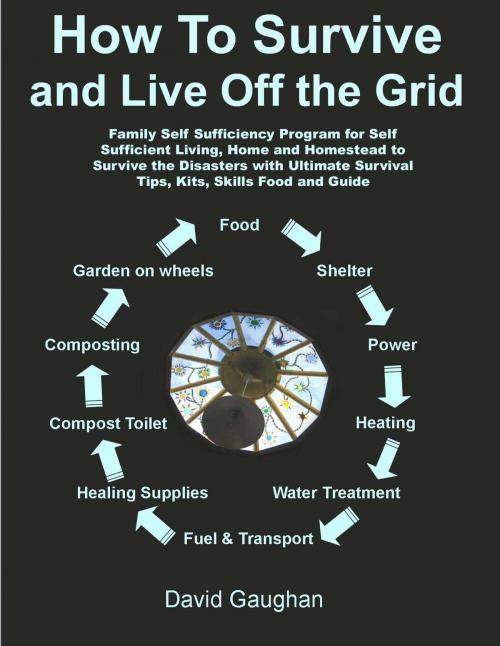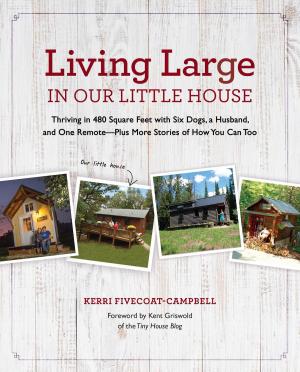How To Survive and Live Off the Grid: Family Self Sufficiency Program for Self Sufficient Living, Home and Homestead to Survive the Disasters with Ultimate Survival Tips, Kits, Skills Food and Guide
Nonfiction, Reference & Language, Education & Teaching, Reference, Guides & Handbooks| Author: | David Gaughan | ISBN: | 9781310425554 |
| Publisher: | David Gaughan | Publication: | January 15, 2016 |
| Imprint: | Smashwords Edition | Language: | English |
| Author: | David Gaughan |
| ISBN: | 9781310425554 |
| Publisher: | David Gaughan |
| Publication: | January 15, 2016 |
| Imprint: | Smashwords Edition |
| Language: | English |
Whether your goal is to be prepared for emergency or simply to be self reliant and off the grid, the Self Sufficiency Survival guide and manual will give you ideas to cover the basics of what you need. If an earthquake struck today, or any other natural disaster, the power, water and sewage can be knocked out for extended periods, possibly months. So where do you go to the toilet?
Although everyone talks about being prepared for an emergency event, very few actually know what to do when disaster strikes. And in these days of multiple uncertainties, ranging from economic fallout, increasing climatic extremes and earth changes, it pays to prepare for the worst and hope for the best.
Regardless of whether your goal is for green living self sufficiency or emergency preparedness, the most basic necessities need to be addressed. These include water treatment, hygiene, ablutions, shelter, food treatment and storage, power generation, hot water, heating, fuel and transport. The Self Sufficiency Survival guide and manual will give you ideas for all of these.
The most basic needs, like where to go to the toilet, is a common problem that happens in every such case, whether it be a Third World country or modern city. People in Haiti and also Christchurch New Zealand were still experiencing the effects over two years after their earthquakes.
Converting a high-top van with simple low-cost techniques can make economic sense because you can use it for convenient weekend holidays away from home and it’s handy if you need it in an emergency. However, if that’s not possible for you, there are other things you can do.
Ideally you’ll prepare for an emergency event before it strikes - as the Chinese saying goes, better to fix the roof while the sun is shining.
With a little imagination and determination it’s possible to be self sufficient in our modern age, even when living in the city suburbs. In Indonesia they have public toilets that are completely self contained. The water system, the recycling of the wastewater, the filtration system is all done naturally. There are also hotels that employ that natural system, flushing out the industrial wastes and detergents using an eco-friendly natural system.
The wastewater, including sewage is flushed into a chamber with a blade that breaks up the solids into slurry. After it’s passed through a series of chambers in the filtering process, the liquid passes through a gravel reed bed, while the solids in the chambers break down through natural enzymes. The gravel reed bed consists of various grades of material that acts as a natural filter. The reeds and water plants in the gravel bed thrive on the constant supply of nutrient rich fluids and the water that comes out the other end is purified by the process. The water is then used to feed the gardens.
The reason these big hotels are employing this natural process is not just to be eco-friendly, but also because their water bills are so high. It makes economic sense to plumb their developments to capture water from the roof and divert the waste around the structure to their in-ground filtering system that feeds their gardens. The reed beds create a beautiful garden feature and the roots of the plants in these beds a packed solid, taking in the nutrients from the flowing hydroponic system.
The same thing is achievable for individual homes and small communities. The cost savings from getting away from reliance on public systems offsets the initial set-up costs.
Of course, the journey to self sufficiency, like any journey, begins with the first basic steps. In the first section of the manual we’ll cover the main items you’ll need, starting with the easy to obtain and building up to “great to have”. Depending on your living situation, you may not have the storage facilities for some of the larger items, but everyone can start with the basics, even if only on a small scale.
Items are listed along with a basic description of their uses.
Whether your goal is to be prepared for emergency or simply to be self reliant and off the grid, the Self Sufficiency Survival guide and manual will give you ideas to cover the basics of what you need. If an earthquake struck today, or any other natural disaster, the power, water and sewage can be knocked out for extended periods, possibly months. So where do you go to the toilet?
Although everyone talks about being prepared for an emergency event, very few actually know what to do when disaster strikes. And in these days of multiple uncertainties, ranging from economic fallout, increasing climatic extremes and earth changes, it pays to prepare for the worst and hope for the best.
Regardless of whether your goal is for green living self sufficiency or emergency preparedness, the most basic necessities need to be addressed. These include water treatment, hygiene, ablutions, shelter, food treatment and storage, power generation, hot water, heating, fuel and transport. The Self Sufficiency Survival guide and manual will give you ideas for all of these.
The most basic needs, like where to go to the toilet, is a common problem that happens in every such case, whether it be a Third World country or modern city. People in Haiti and also Christchurch New Zealand were still experiencing the effects over two years after their earthquakes.
Converting a high-top van with simple low-cost techniques can make economic sense because you can use it for convenient weekend holidays away from home and it’s handy if you need it in an emergency. However, if that’s not possible for you, there are other things you can do.
Ideally you’ll prepare for an emergency event before it strikes - as the Chinese saying goes, better to fix the roof while the sun is shining.
With a little imagination and determination it’s possible to be self sufficient in our modern age, even when living in the city suburbs. In Indonesia they have public toilets that are completely self contained. The water system, the recycling of the wastewater, the filtration system is all done naturally. There are also hotels that employ that natural system, flushing out the industrial wastes and detergents using an eco-friendly natural system.
The wastewater, including sewage is flushed into a chamber with a blade that breaks up the solids into slurry. After it’s passed through a series of chambers in the filtering process, the liquid passes through a gravel reed bed, while the solids in the chambers break down through natural enzymes. The gravel reed bed consists of various grades of material that acts as a natural filter. The reeds and water plants in the gravel bed thrive on the constant supply of nutrient rich fluids and the water that comes out the other end is purified by the process. The water is then used to feed the gardens.
The reason these big hotels are employing this natural process is not just to be eco-friendly, but also because their water bills are so high. It makes economic sense to plumb their developments to capture water from the roof and divert the waste around the structure to their in-ground filtering system that feeds their gardens. The reed beds create a beautiful garden feature and the roots of the plants in these beds a packed solid, taking in the nutrients from the flowing hydroponic system.
The same thing is achievable for individual homes and small communities. The cost savings from getting away from reliance on public systems offsets the initial set-up costs.
Of course, the journey to self sufficiency, like any journey, begins with the first basic steps. In the first section of the manual we’ll cover the main items you’ll need, starting with the easy to obtain and building up to “great to have”. Depending on your living situation, you may not have the storage facilities for some of the larger items, but everyone can start with the basics, even if only on a small scale.
Items are listed along with a basic description of their uses.















